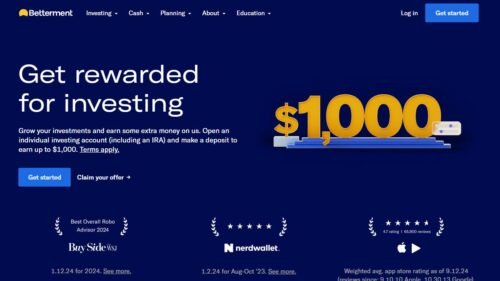Table of Contents
Are you wondering how Betterment Robo Advisor can help you grow your wealth effortlessly? Do you want to know if automated investing is the right choice for your financial goals? With so many investment options available, it’s natural to feel overwhelmed when trying to maximize your returns.
In this article, we’ll explore how Betterment Robo Advisor works, its key benefits, and how it stacks up against traditional financial advisors. Whether you’re a beginner or an experienced investor, understanding how Betterment’s automated strategies can optimize your portfolio is essential to making informed decisions.
Let’s dive in and discover if Betterment Robo Advisor is the right tool to take your investments to the next level.
Introduction to Betterment Robo Advisor
Investing can feel complicated, but Betterment Robo Advisor aims to simplify the process with its automated approach. Whether you’re new to investing or looking for a hands-off strategy, Betterment offers a solution that balances cost-effectiveness with professional-grade investment strategies.
In this section, we’ll explore what Betterment Robo Advisor is, how it operates, and the unique features that make it stand out in the crowded world of automated investing.
What Is Betterment Robo Advisor?
Betterment Robo Advisor is an automated investment platform that helps individuals manage their finances with minimal effort. It leverages sophisticated algorithms to create and maintain a diversified portfolio tailored to an investor’s goals and risk tolerance. Unlike traditional financial advisors, Betterment provides a low-cost, data-driven solution that makes investing accessible to everyone.
The platform offers a variety of portfolio options, including stock and bond allocations based on modern portfolio theory (MPT). Whether you’re planning for retirement, a major purchase, or simply growing your wealth, Betterment provides a guided approach designed to optimize your returns while minimizing risk.
One of the key advantages of using Betterment Robo Advisor is its hands-off approach. Once you set your goals, the platform takes care of the rest—rebalancing, tax-loss harvesting, and optimizing your asset allocation over time. This automated system allows you to focus on your financial goals without the stress of managing investments manually.
If you’re someone who struggles with making investment decisions or lacks the time to monitor the market closely, Betterment can be an ideal solution. It offers an intuitive experience backed by proven investment strategies, helping you achieve financial growth with minimal effort.
Pro Tip: Start with Betterment’s risk assessment tool to get personalized portfolio recommendations based on your financial situation and goals.
How Does Betterment Robo Advisor Work?
Betterment operates using advanced algorithms that analyze your financial profile and investment goals to create a customized portfolio. The process starts by asking you a series of questions to determine your risk tolerance, timeline, and financial objectives. Based on your responses, Betterment selects an optimized mix of assets tailored to your needs.
Once your portfolio is set up, the platform continuously monitors your investments and makes adjustments as needed. For instance, if market fluctuations shift your portfolio’s asset allocation away from the intended balance, Betterment automatically rebalances it to align with your original goals. This helps maintain a consistent risk level and maximizes potential returns over time.
A standout feature of Betterment is its tax-loss harvesting, which strategically sells investments at a loss to offset capital gains and reduce your tax liability. This feature can provide significant savings, especially for high-income investors.
Betterment also offers socially responsible investing (SRI) options for those who want their investments to align with their values. This allows users to invest in companies that prioritize environmental, social, and governance (ESG) factors without sacrificing financial returns.
The platform’s goal-based approach means that whether you’re saving for a home, retirement, or a vacation, Betterment tailors your investment plan to meet your specific financial milestones. The automated process takes the guesswork out of investing, making it easy for beginners and experienced investors alike.
Expert Tip: Regularly review your investment goals in Betterment to ensure your portfolio aligns with any life changes or new financial priorities.
Key Features That Set Betterment Apart
Betterment Robo Advisor stands out in the competitive robo-advisory market due to its innovative features that cater to a wide range of investors. Some of the key elements that make Betterment unique include:
- Goal-Based Investing: Betterment’s platform helps users set specific financial goals and tailors investment strategies accordingly. Whether you’re planning for retirement or an emergency fund, Betterment aligns its recommendations with your objectives.
- Automated Rebalancing: Your portfolio is consistently monitored and adjusted to maintain the optimal asset allocation, ensuring long-term growth potential with minimal risk.
- Tax-Efficient Strategies: The platform offers tax-loss harvesting and tax-efficient asset allocation, helping investors reduce their tax burden and enhance after-tax returns.
- Diverse Portfolio Options: Betterment provides a mix of ETFs covering various asset classes, including U.S. and international stocks, bonds, and socially responsible investments.
- Low-Cost Investment Management: With transparent pricing and no hidden fees, Betterment is a cost-effective alternative to traditional financial advisors, allowing you to maximize returns without high management costs.
- Smart Withdrawal Strategies: For retirees or those nearing financial goals, Betterment offers strategies to withdraw funds efficiently while minimizing tax implications.
Betterment’s combination of automation, low fees, and expert-level financial strategies makes it an attractive choice for investors seeking an efficient and personalized investment experience. Whether you’re a hands-off investor or someone looking to grow wealth steadily, Betterment provides the tools and insights needed to achieve your financial goals.
Best Practice: Take advantage of Betterment’s financial planning tools and calculators to get a clearer picture of how your investments can support your future aspirations.
Benefits of Using Betterment Robo Advisor

Investors today seek smart, cost-effective solutions to grow their wealth, and Betterment Robo Advisor offers a range of benefits designed to simplify the investment process. From automated portfolio management to tax-efficient strategies, Betterment provides an intuitive platform that helps individuals achieve their financial goals with minimal effort.
Let’s take a closer look at the key advantages that make Betterment a popular choice among investors.
Automated Portfolio Management
One of the most significant advantages of Betterment Robo Advisor is its automated portfolio management, which takes the guesswork out of investing. Rather than manually selecting and rebalancing assets, Betterment uses sophisticated algorithms to build and maintain an optimized investment portfolio based on an individual’s goals and risk tolerance.
The platform continuously monitors market trends and adjusts investments accordingly, ensuring that the asset allocation remains aligned with long-term financial objectives. Whether the market is booming or facing downturns, Betterment automatically rebalances the portfolio to maintain diversification and minimize risks.
Investors benefit from a passive, hands-off approach that eliminates the need for constant market research and decision-making. The system efficiently allocates funds across various asset classes, such as stocks and bonds, to maximize returns while keeping risks in check.
With Betterment’s automated management, users can focus on their financial goals without getting bogged down in the complexities of investment strategies. This feature is particularly useful for beginners or busy professionals who lack the time or expertise to manage their investments manually.
Pro Tip: Regularly review your investment goals in Betterment to ensure the automated management aligns with any life changes or financial shifts.
Low-Cost Investment Options
One of the standout features of Betterment Robo Advisor is its affordable fee structure, which makes professional investment management accessible to a broader audience. Traditional financial advisors often charge hefty fees, but Betterment offers a cost-effective alternative without compromising on quality.
Betterment’s pricing model is straightforward and transparent, with fees starting at 0.25% of assets under management for the basic plan. This is significantly lower than the 1% or more typically charged by human financial advisors. By keeping fees low, Betterment allows investors to retain more of their returns, leading to better long-term wealth accumulation.
Beyond management fees, the platform uses low-cost exchange-traded funds (ETFs) to construct portfolios. These ETFs have lower expense ratios compared to actively managed mutual funds, reducing overall costs even further.
For those looking to minimize expenses without sacrificing professional oversight, Betterment provides an ideal solution. Investors can enjoy sophisticated financial strategies and tax-saving features at a fraction of the cost of traditional investment options.
Expert Tip: Opt for Betterment’s basic plan if you’re looking for low-cost, automated investing without needing access to a human advisor.
Tax-Loss Harvesting Strategies
Tax efficiency is a crucial aspect of successful investing, and Betterment Robo Advisor incorporates tax-loss harvesting to help investors reduce their tax liabilities. This feature allows the platform to automatically sell underperforming assets at a loss to offset taxable gains, ultimately lowering the amount owed to the IRS.
Betterment’s tax-loss harvesting is designed to be seamless and continuous, ensuring that opportunities to reduce taxes are not missed throughout the year. This strategy can be particularly beneficial for high-income investors who face significant tax burdens on capital gains.
Another advantage of Betterment’s tax-smart strategies is asset location optimization, which involves placing tax-inefficient assets in tax-advantaged accounts such as IRAs, while allocating tax-efficient assets to taxable accounts. This strategic placement enhances after-tax returns over time.
Investors who contribute regularly to their Betterment account can maximize tax savings without the hassle of manual tax planning. The automated system ensures that tax-saving opportunities are consistently applied across the portfolio.
Best Practice: If you have taxable investment accounts, enable Betterment’s tax-loss harvesting feature to maximize after-tax returns effortlessly.
Goal-Based Investment Planning
Betterment stands out with its goal-based investment approach, which allows users to invest with specific financial objectives in mind. Whether saving for retirement, a major purchase, or building an emergency fund, Betterment provides personalized recommendations to align with each goal.
When setting up an account, investors are prompted to select their goals and timelines. The platform then suggests an appropriate portfolio mix based on factors such as risk tolerance, expected returns, and investment horizon. This personalized approach ensures that each investor is on track to meet their unique financial aspirations.
Betterment’s goal-tracking feature provides progress updates and actionable insights, helping users stay motivated and make informed decisions. The system also offers adjustable settings, allowing investors to modify their goals as life circumstances change.
For those seeking financial clarity and direction, Betterment’s goal-based planning offers a structured approach that removes uncertainty and provides a clear path toward financial security.
Pro Tip: Set up multiple goals within Betterment to allocate your investments efficiently across short-term and long-term financial needs.
Betterment vs. Traditional Financial Advisors
When deciding between Betterment Robo Advisor and traditional financial advisors, it’s important to understand how they compare in terms of cost, performance, and suitability for various investment goals. While both options provide valuable financial management services, Betterment offers a tech-driven, cost-effective solution, whereas traditional advisors provide personalized, hands-on guidance. L
et’s explore how these two investment options stack up against each other.
Cost Comparison: Robo Advisor vs. Human Advisor
Cost is often a deciding factor when choosing between a robo advisor like Betterment and a traditional financial advisor. Betterment Robo Advisor provides an affordable solution by automating investment processes, eliminating the high fees associated with human advisors.
Traditional financial advisors typically charge fees ranging from 1% to 2% of assets under management (AUM). In contrast, Betterment offers a competitive pricing structure starting at just 0.25% AUM for its basic plan and 0.40% AUM for its premium plan, which includes access to human advisors for more personalized guidance.
The cost savings don’t stop at management fees. Traditional advisors may include additional fees for consultations, account maintenance, and even commissions on certain investment products. Betterment, on the other hand, offers transparent pricing with no hidden charges, ensuring investors know exactly what they’re paying for.
By leveraging automation and low-cost exchange-traded funds (ETFs), Betterment helps investors keep more of their returns over time, making it an attractive option for those looking to grow their wealth without excessive costs.
Pro Tip: If you have straightforward investment goals and prefer low fees, Betterment’s pricing model can be a cost-effective solution compared to traditional advisors.
Performance and Efficiency Differences
When it comes to investment performance and efficiency, both Betterment Robo Advisor and traditional financial advisors bring unique advantages to the table. Betterment utilizes advanced algorithms and data-driven insights to build and maintain diversified portfolios tailored to individual goals.
Robo advisors are designed to remove emotional decision-making, which often leads to better long-term performance. Betterment continuously rebalances portfolios based on market fluctuations and ensures diversification across asset classes such as stocks, bonds, and alternative investments.
On the other hand, traditional financial advisors bring a personalized touch to investment management. They can offer customized financial plans, estate planning, and tax strategies tailored to an investor’s unique circumstances. However, human advisors may introduce biases, and their investment decisions might not always align with market data.
Betterment’s algorithm-driven approach provides efficient, consistent performance without the potential for human error. It ensures that every investment decision is backed by analytical data rather than subjective opinions.
Expert Tip: Investors who prefer data-backed, automated efficiency may find Betterment to be a more reliable and cost-effective alternative compared to human advisors.
Suitability for Different Investment Goals
Choosing between Betterment Robo Advisor and a traditional financial advisor often comes down to individual investment goals and preferences. Betterment excels in goal-based investing, offering tailored portfolios for retirement planning, emergency funds, and wealth accumulation through automated strategies.
Betterment’s platform is ideal for individuals who prefer a hands-off investment approach and want their portfolios aligned with long-term goals without frequent adjustments. The goal-tracking features allow users to monitor their progress and make informed decisions without professional guidance.
In contrast, traditional financial advisors may be better suited for individuals with complex financial needs, such as estate planning, business investments, or tax optimization for high-net-worth individuals. Human advisors offer a comprehensive, personalized approach that goes beyond simple investment management.
However, Betterment has bridged this gap with its premium plan, offering human advisor support alongside automated portfolio management. This hybrid approach provides the best of both worlds for those who want a blend of personalized advice and automation.
Best Practice: If your investment goals are straightforward, Betterment’s automated approach can be highly effective. However, for more complex financial planning, traditional advisors may provide greater value.
How to Get Started with Betterment Robo Advisor

Starting your investment journey with Betterment Robo Advisor is a straightforward process that helps you build a well-structured portfolio tailored to your financial goals. Whether you’re planning for retirement, saving for a big purchase, or simply looking to grow your wealth, Betterment offers a user-friendly experience that guides you through each step.
Let’s explore how you can get started effectively and make the most out of Betterment’s features.
Setting Up Your Investment Goals
The first step in using Betterment Robo Advisor is defining your investment goals, which will determine how your portfolio is structured. Betterment offers a goal-based investing approach, allowing users to allocate funds toward specific objectives such as retirement, emergency funds, or general wealth accumulation.
When setting up your account, Betterment prompts you to select from predefined goals or create a custom one based on your financial needs. Each goal comes with a suggested timeline and risk profile, ensuring that your investments align with your expectations and future plans.
Having clear investment goals is crucial because it influences the types of assets Betterment selects for your portfolio. Whether your focus is long-term growth or short-term stability, the platform tailors your asset allocation accordingly.
Betterment also provides tools to help you estimate how much you need to invest to achieve your goals within a given timeframe. These insights can help you set realistic expectations and track your progress effectively.
Pro Tip: Regularly review and adjust your goals in Betterment to stay on track as your financial situation evolves.
Choosing the Right Portfolio Strategy
Once you’ve established your goals, the next step is selecting a portfolio strategy that aligns with your investment preferences. Betterment offers a variety of portfolio options, ranging from standard diversified portfolios to socially responsible investing (SRI) options.
The platform primarily uses low-cost exchange-traded funds (ETFs) to build diversified portfolios across different asset classes, including U.S. and international stocks, bonds, and alternative investments. Betterment’s portfolios are designed using modern portfolio theory (MPT), ensuring an optimal balance of risk and return.
If you’re passionate about ethical investing, Betterment’s Socially Responsible Investing (SRI) portfolios allow you to support companies that prioritize environmental, social, and governance (ESG) criteria while still pursuing strong financial returns.
For investors seeking minimal risk, Betterment offers a conservative allocation, which focuses on bonds and fixed-income securities. Conversely, those looking for higher returns may opt for a more aggressive allocation that leans heavily on equities.
Expert Tip: Choose a portfolio that reflects your comfort with market fluctuations and aligns with your long-term financial objectives.
Understanding Risk Tolerance and Allocation
Risk tolerance plays a critical role in how your investments are managed within Betterment Robo Advisor. During the onboarding process, Betterment asks questions to assess your comfort level with market volatility and potential losses. Based on your answers, the platform suggests an appropriate mix of stocks and bonds to balance risk and reward.
For investors with a high-risk tolerance, Betterment may recommend a portfolio with a larger proportion of equities, which historically offer higher returns but come with increased volatility. On the other hand, conservative investors may prefer portfolios with a higher allocation to bonds, which provide stability but lower growth potential.
Betterment also employs automatic rebalancing, ensuring your portfolio remains aligned with your risk tolerance over time. If market conditions shift, the platform adjusts the allocation to maintain your desired level of risk.
It’s important to periodically reassess your risk tolerance, especially during major life events such as marriage, having children, or nearing retirement. Adjusting your investment strategy accordingly ensures that you stay on track to meet your financial goals.
Best Practice: Evaluate your risk profile annually to make sure it aligns with your current financial situation and investment outlook.
Funding Your Account and Making Your First Investment
After setting your goals and selecting your portfolio strategy, the final step is funding your Betterment account and making your first investment. Betterment makes the funding process simple, offering multiple ways to deposit funds, including bank transfers, direct rollovers from existing accounts, and recurring contributions.
To get started, link your bank account securely to Betterment. Once the connection is established, you can transfer a lump sum or set up automated deposits to contribute regularly. Automating your contributions is an excellent way to build wealth consistently without having to remember to transfer funds manually.
Betterment offers tax-efficient features, such as tax-coordinated portfolios and tax-loss harvesting, which help optimize the placement of your funds across taxable and tax-advantaged accounts. These features ensure that your investments are structured in the most efficient way possible to minimize tax liabilities.
Once your funds are deposited, Betterment immediately invests them according to your chosen strategy. The platform continuously monitors your investments, ensuring they align with your goals while maximizing returns.
Pro Tip: Set up automatic contributions to take advantage of dollar-cost averaging, which helps mitigate the impact of market fluctuations on your investments.
Betterment Robo Advisor Investment Strategies
Investing with Betterment Robo Advisor offers a variety of strategies tailored to different financial goals and risk preferences. Whether you’re looking for a passive investment approach, a diversified portfolio, or socially responsible options, Betterment provides an intelligent, automated system designed to optimize your returns.
Understanding these strategies can help you make informed choices that align with your long-term financial objectives.
Passive vs. Active Investment Approaches
When it comes to investment styles, Betterment primarily focuses on passive investing, which aims to maximize returns over the long term while minimizing fees and effort. Passive investing involves holding a diversified portfolio of assets, such as exchange-traded funds (ETFs), that mirror the performance of the market rather than attempting to beat it.
Betterment’s passive investment approach is rooted in modern portfolio theory (MPT), which emphasizes risk diversification and asset allocation based on an investor’s risk tolerance and goals. The robo advisor continuously monitors market conditions and rebalances portfolios as needed to maintain the desired asset mix.
In contrast, active investing involves frequent buying and selling of securities in an attempt to outperform the market. While active strategies may appeal to those seeking short-term gains, they often come with higher fees and increased risk due to market fluctuations.
Betterment’s automated platform is designed for investors who prefer a hands-off experience, allowing them to achieve steady growth without the complexities of active trading. By leveraging automation, Betterment eliminates the emotional biases that can impact investment decisions, providing a consistent and disciplined approach to wealth building.
Pro Tip: If you’re looking for steady, long-term growth with minimal effort, Betterment’s passive investment approach may be the best fit for your financial goals.
Asset Allocation and Diversification Techniques
Asset allocation and diversification are key components of Betterment’s investment strategy. The platform uses a mix of asset classes—including stocks, bonds, and cash equivalents—to create a balanced portfolio that aligns with an investor’s risk tolerance and time horizon.
Betterment’s asset allocation strategy involves spreading investments across multiple asset types to reduce overall risk. For example, if one asset class underperforms, gains in another can help offset the losses. This diversification helps investors achieve a more stable and predictable return over time.
The platform offers both domestic and international exposure, ensuring that portfolios are well-balanced across different markets and economic sectors. Betterment also considers factors such as an investor’s income level, liquidity needs, and long-term objectives when recommending an asset allocation strategy.
Rebalancing is another crucial aspect of Betterment’s approach. As market conditions change, the robo advisor automatically adjusts the portfolio to maintain the desired asset allocation, ensuring that investors stay on track with their financial goals without needing to make manual adjustments.
Best Practice: Regularly review your asset allocation preferences in Betterment to ensure they align with your evolving financial situation and risk appetite.
Socially Responsible Investing (SRI) Options
For investors looking to align their financial goals with their personal values, Betterment offers Socially Responsible Investing (SRI) options. These portfolios are designed to support companies that prioritize environmental, social, and governance (ESG) factors, such as sustainable business practices, diversity and inclusion, and ethical corporate governance.
Betterment’s SRI portfolios focus on companies that promote clean energy, responsible labor practices, and corporate transparency, helping investors contribute to positive social impact while still aiming for strong financial returns.
The platform offers different levels of socially responsible investing, allowing investors to choose between broad ESG-focused funds or specific themes, such as climate-conscious investing. Betterment’s automated system ensures that these investments are still diversified and aligned with an individual’s risk tolerance and long-term goals.
Investing in SRI options does not mean sacrificing performance. Research has shown that companies with strong ESG practices often exhibit long-term resilience and stability, making them attractive choices for sustainable wealth growth.
Expert Tip: If ethical investing is important to you, explore Betterment’s SRI options to align your portfolio with your values without compromising financial returns.
Retirement Planning with Betterment
Betterment Robo Advisor offers a comprehensive suite of retirement planning tools that make it easy to save for the future. Whether you’re planning for retirement decades in advance or looking to optimize existing retirement accounts, Betterment provides personalized strategies based on your desired retirement age, income needs, and risk tolerance.
One of Betterment’s standout features is its Retirement Goal Tracker, which analyzes your savings and projected growth to determine if you’re on track to meet your retirement goals. The platform also provides recommendations for optimizing contributions to tax-advantaged accounts such as IRAs and 401(k) rollovers, helping to maximize tax benefits and long-term growth potential.
Betterment’s tax-efficient strategies, such as tax-loss harvesting and tax-coordinated portfolios, ensure that investors can minimize tax burdens and keep more of their returns over time. These features are especially beneficial for high-income earners looking to optimize their retirement savings.
For those nearing retirement, Betterment offers drawdown strategies that help retirees withdraw funds strategically to extend their retirement savings while minimizing tax liabilities. This ensures a steady income stream without depleting savings too quickly.
Best Practice: Regularly review your retirement plan within Betterment to ensure your contributions and investment strategy align with your evolving financial needs.
Betterment Fees and Pricing Structure

Understanding the cost of investing is essential when choosing an automated platform like Betterment Robo Advisor. The platform offers a transparent and competitive pricing model that caters to both beginners and experienced investors. In this section, we’ll explore how Betterment structures its fees, compare its costs to other robo advisors, and highlight potential hidden charges to be aware of.
Understanding the Fee Structure
Betterment Robo Advisor follows a straightforward pricing structure that provides investors with flexibility and affordability. It offers two main service tiers: the Digital Plan and the Premium Plan, each designed to meet different investment needs and levels of financial guidance.
The Digital Plan, Betterment’s entry-level offering, charges an annual fee of 0.25% of assets under management (AUM). This plan includes features such as automatic rebalancing, tax-loss harvesting, goal-based investing, and personalized financial planning tools. It’s an ideal choice for investors who prefer a hands-off approach while still benefiting from professional management.
For those seeking more personalized financial advice, the Premium Plan is available at an annual fee of 0.40% AUM. This plan includes all features of the Digital Plan but adds unlimited access to certified financial planners (CFPs), providing tailored advice for complex financial situations such as estate planning or retirement strategies.
Betterment does not impose trading fees, transfer fees, or withdrawal fees, making it a cost-effective solution compared to traditional brokerage firms. However, investors should be aware of ETF expense ratios, which typically range from 0.03% to 0.15%, depending on the selected portfolio. These costs are not charged directly by Betterment but are inherent to the investment products used within portfolios.
Pro Tip: Consider the Digital Plan if you’re comfortable with automated investing and don’t require one-on-one advice. The Premium Plan may be suitable if you need human guidance alongside automated services.
Comparing Betterment’s Fees to Competitors
When comparing the costs of Betterment Robo Advisor to its competitors, it becomes clear that the platform offers a competitive edge in affordability and value. Robo advisors such as Wealthfront, Vanguard Personal Advisor, and Charles Schwab Intelligent Portfolios have similar fee structures, but Betterment stands out in terms of features and user experience.
- Wealthfront: Charges the same 0.25% AUM fee as Betterment’s Digital Plan but offers slightly different services, such as a focus on tax-advantaged strategies and borrowing options. However, it lacks the option for human financial advice unless upgraded to premium plans.
- Vanguard Personal Advisor Services: With a fee of 0.30% AUM, Vanguard offers access to human advisors but requires a minimum investment of $50,000, which may be a barrier for beginner investors.
- Charles Schwab Intelligent Portfolios: Offers zero management fees, but requires a minimum cash balance in the portfolio, which can limit growth potential compared to fully invested portfolios like Betterment.
Betterment’s lower fees and flexibility make it an attractive option for individuals who prioritize low-cost, hands-off investing while still benefiting from valuable financial tools and resources.
Expert Tip: Compare robo advisors not just on fees, but also on additional services such as tax-loss harvesting and financial planning features to determine the best value for your investment style.
Hidden Costs to Watch Out For
While Betterment’s pricing structure is transparent, investors should be mindful of potential hidden costs that can impact their overall returns. One such cost is ETF expense ratios, which, although minimal, can add up over time and slightly reduce net returns. These expense ratios are built into the investment products Betterment selects but are not unique to the platform itself.
Another consideration is advisory fees on external accounts, which may arise if you choose to consolidate your financial accounts and seek personalized advice from Betterment’s CFP professionals. These services are available through the Premium Plan and come at an additional cost if expanded beyond the core investment management services.
Investors should also consider the impact of taxes on withdrawals, particularly from taxable accounts. Although Betterment optimizes portfolios for tax efficiency through strategies such as tax-loss harvesting, capital gains taxes may still apply when selling investments.
For those investing in 401(k) plans through Betterment, administrative fees may be applicable, depending on the employer’s plan provider. It’s important to review plan-specific fees to understand how they might affect long-term growth.
Best Practice: Review the fine print of any financial service and understand how associated costs such as ETF expense ratios and tax implications might influence your overall investment performance.
Risks and Limitations of Using Betterment
While Betterment Robo Advisor offers many benefits, it’s important to consider potential risks and limitations before committing your investments. Like any financial tool, Betterment has certain drawbacks that might not align with every investor’s needs.
Factors such as market volatility, limited human interaction, and the constraints of automated investing can impact your experience and financial outcomes. Understanding these risks can help you make an informed decision.
Market Volatility and Performance Fluctuations
Investing in financial markets always carries the risk of market volatility, and Betterment is no exception. Since Betterment relies on passive investment strategies through diversified portfolios of stocks and bonds, investors are still exposed to fluctuations caused by economic downturns, geopolitical events, and changes in interest rates.
While Betterment’s automated rebalancing helps maintain the desired asset allocation, it cannot eliminate the risks associated with market movements. During periods of high volatility, portfolio values may experience sudden drops, which can be unsettling for investors who are not prepared for short-term fluctuations.
Another key consideration is the long-term nature of Betterment’s investment strategy. The platform is designed to encourage disciplined, goal-oriented investing, but those seeking quick profits might find the lack of active trading strategies limiting. The passive approach works well for long-term growth but might not satisfy investors who prefer a more hands-on approach to capitalize on market opportunities.
It’s essential to set realistic expectations and understand that Betterment’s investment strategy aims for steady growth over time rather than short-term gains. Investors should stay focused on their long-term goals and avoid making impulsive decisions during market downturns.
Pro Tip: To manage market volatility effectively, diversify your investments across different goal-based portfolios and maintain a long-term perspective to ride out fluctuations.
Limited Human Interaction and Support
One of the most common concerns with using Betterment Robo Advisor is the limited human interaction compared to traditional financial advisory services. While the platform provides valuable automated tools and insights, it lacks the personalized touch that some investors might prefer when making important financial decisions.
The Digital Plan offers no direct access to financial advisors, which means users must rely solely on the automated system for guidance. Although Betterment provides extensive educational resources and goal-tracking features, some investors might feel the need for one-on-one advice, especially when dealing with complex financial situations like tax planning or estate management.
For those seeking human interaction, Betterment’s Premium Plan includes access to certified financial planners, but this service comes at a higher cost (0.40% AUM). While the Premium Plan offers valuable advice, it still falls short of the in-depth, face-to-face consultations offered by traditional advisors.
Investors who value the reassurance and tailored guidance of a dedicated financial advisor may find Betterment’s automated nature limiting, particularly when navigating major life changes such as retirement planning, buying a home, or adjusting investment strategies during volatile periods.
Expert Tip: If you require personalized financial advice, consider upgrading to the Premium Plan or supplementing Betterment with occasional consultations from a certified financial planner.
Potential Downsides of Automated Investing
Automated investing offers convenience and efficiency, but it comes with certain downsides that investors should be aware of. One of the biggest limitations is the lack of emotional intelligence that human advisors provide. While Betterment’s algorithms are designed to make data-driven investment decisions, they cannot take into account personal nuances, such as changing financial priorities or unexpected life events that might require portfolio adjustments.
Another challenge is the one-size-fits-all approach, where investment strategies are based on pre-defined risk tolerance levels and goals. Although Betterment customizes portfolios to an extent, the platform may not be flexible enough for investors with highly specific needs or unique financial circumstances.
Betterment’s reliance on automation can also lead to a lack of customization in asset selection. Unlike working with a financial advisor who can tailor an investment plan down to the individual stock level, Betterment primarily invests in low-cost ETFs, which limits options for those looking for greater control over their investment choices.
Finally, while Betterment’s algorithm-driven approach eliminates emotional decision-making, it might not adapt well to unexpected market conditions that require nuanced human judgment. Automated investing may not always recognize opportunities or risks that a skilled financial professional would.
Best Practice: If you prefer more control over your investment decisions, use Betterment as a supplemental tool rather than your sole investment strategy.
User Experience and Mobile App Features

A smooth and intuitive user experience is essential when choosing an investment platform, and Betterment Robo Advisor excels in offering an easy-to-use interface that simplifies wealth management. Whether you’re accessing the platform through the desktop dashboard or the mobile app, Betterment ensures seamless navigation, insightful financial tools, and convenient support options. Let’s explore the key aspects that make Betterment’s user experience stand out.
Navigating the Betterment Dashboard
The Betterment dashboard is designed to provide investors with a clear, organized view of their financial progress. It features a user-friendly interface that presents key investment data, such as portfolio performance, goal tracking, and recent transactions, all in one place.
Upon logging in, users are greeted with an overview of their portfolio, showing current balances, projected returns, and how their investments align with their financial goals. This level of transparency makes it easy to stay informed about progress without getting overwhelmed by complex financial data.
One of the most useful features of the dashboard is the goal-based investing section, which helps users visualize their financial objectives. Whether you’re saving for retirement, an emergency fund, or other goals, the dashboard provides tailored suggestions and insights to keep you on track.
Betterment also integrates tools like tax-loss harvesting summaries, risk allocation breakdowns, and expense tracking, making it easier to analyze the efficiency of your investments. The platform provides proactive recommendations, helping users make informed adjustments based on their financial situation.
Pro Tip: Use the insights provided on the dashboard to adjust your savings rate and asset allocation as your financial goals evolve over time.
Mobile App Capabilities and Usability
The Betterment mobile app brings the power of automated investing to your fingertips with a sleek and intuitive design. Available for both iOS and Android devices, the app ensures investors can monitor their portfolios, adjust settings, and execute transactions effortlessly, no matter where they are.
The app’s home screen provides a snapshot of portfolio performance, including real-time balances, goal progress, and allocation breakdowns. Users can drill down into individual goals to see their projected growth and make adjustments as needed.
A standout feature of the Betterment mobile app is its automatic deposit management, which allows users to set up recurring contributions with just a few taps. This feature helps investors stay disciplined by making regular contributions without manual intervention.
Security is another priority within the app, with features such as two-factor authentication, biometric login, and encryption ensuring that user data remains protected at all times.
Navigation within the app is intuitive, with a minimalist design that guides users effortlessly through different sections, including performance analysis, tax strategies, and account settings. Even beginners can easily access information and make investment decisions without feeling overwhelmed.
Expert Tip: Enable push notifications on the Betterment app to receive timely updates about your account performance and important financial milestones.
Customer Support Options Available
When it comes to customer support, Betterment offers a variety of convenient options to assist users with their investment needs. While the platform is largely automated, it ensures that investors have access to professional guidance when necessary.
For general inquiries, Betterment provides an extensive Help Center, which includes FAQs, guides, and tutorials covering a wide range of topics, from portfolio strategies to tax optimization techniques. This self-service option allows users to find answers quickly without the need to contact support.
For those who require more personalized assistance, Betterment offers phone and email support during business hours. Their team of financial professionals is available to answer technical questions and provide guidance on investment-related topics.
Investors who opt for the Premium Plan gain unlimited access to certified financial planners (CFPs), allowing for in-depth discussions about financial strategies, retirement planning, and wealth management. This feature bridges the gap between robo advising and traditional human financial advisory services.
Betterment also offers an in-app messaging system that allows users to communicate with support representatives without leaving the platform. This feature is particularly useful for quick questions or clarifications related to portfolio adjustments or account settings.
Best Practice: If you need personalized investment advice, consider upgrading to Betterment’s Premium Plan for direct access to financial experts.
Tips to Maximize Your Returns with Betterment
Investing with Betterment Robo Advisor offers a convenient way to grow your wealth, but optimizing your strategy can help you achieve even better results. By implementing a few smart investing practices, you can take full advantage of Betterment’s features to maximize your long-term returns. Let’s explore how regular contributions, rebalancing, and tax-efficient strategies can boost your investment outcomes.
Regular Contributions and Dollar-Cost Averaging
One of the most effective ways to maximize your returns with Betterment is through regular contributions and dollar-cost averaging (DCA). This strategy involves investing a fixed amount of money at consistent intervals, regardless of market conditions. It helps reduce the impact of market volatility and allows you to take advantage of price fluctuations over time.
By setting up automatic deposits within Betterment, you ensure that you’re consistently investing without having to time the market. Market ups and downs can make it tempting to wait for the “right” time to invest, but with dollar-cost averaging, you spread your investments over time, buying more shares when prices are low and fewer when prices are high.
Regular contributions also help build the habit of saving and investing, which can accelerate the growth of your portfolio. Even small, consistent contributions can compound significantly over time, thanks to Betterment’s automated portfolio management and reinvestment of dividends.
Another advantage of consistent investing is that it helps smooth out emotional decision-making. Rather than reacting to market swings, you stay committed to your long-term financial goals. This disciplined approach can lead to more stable and predictable growth in your investments.
Pro Tip: Set up automated monthly contributions in Betterment to stay consistent and benefit from dollar-cost averaging without the hassle of manual transfers.
Rebalancing Your Portfolio Effectively
Portfolio rebalancing is a crucial aspect of maintaining the right mix of assets to achieve your investment goals. Betterment automatically rebalances your portfolio to ensure that your asset allocation stays in line with your risk tolerance and investment objectives.
Market fluctuations can cause asset weights to drift from their target allocations. For instance, if stocks outperform bonds, your portfolio might become too heavily weighted in equities, increasing your overall risk. Regular rebalancing helps correct this by selling overperforming assets and buying underperforming ones, keeping your risk profile balanced.
Betterment’s algorithm continuously monitors your portfolio and makes small, incremental adjustments to maintain optimal diversification. This process not only helps manage risk but also takes advantage of market inefficiencies by buying low and selling high.
While Betterment automates much of the rebalancing process, it’s still important to review your portfolio periodically. Life events such as marriage, home purchases, or changes in financial goals might require adjustments to your asset allocation.
Expert Tip: Check your Betterment dashboard at least once a year to ensure your portfolio aligns with any changes in your financial situation or risk tolerance.
Leveraging Betterment’s Tax-Efficient Strategies
Tax efficiency is a key factor in maximizing your investment returns, and Betterment offers several features to help minimize your tax burden. One of the most powerful tools available is tax-loss harvesting, which involves selling investments at a loss to offset capital gains, thereby reducing your taxable income.
Betterment’s tax-loss harvesting feature works automatically, scanning your portfolio daily for opportunities to sell underperforming assets and replace them with similar investments. This helps investors lower their tax bills while staying fully invested in the market.
Another tax-efficient feature offered by Betterment is tax-coordinated portfolios. This strategy involves placing tax-inefficient assets, such as bonds, in tax-advantaged accounts like IRAs, while tax-efficient assets, such as index funds, are placed in taxable accounts. This approach helps maximize after-tax returns by optimizing the placement of different asset types.
For investors with long-term goals, Betterment’s automated dividend reinvestment ensures that earnings are reinvested in a tax-efficient manner. Rather than letting dividends sit in cash, they are strategically reinvested based on your portfolio’s target allocation.
Finally, when withdrawing funds, Betterment applies smart withdrawal strategies that aim to minimize taxable events, prioritizing withdrawals from taxable accounts before touching tax-advantaged retirement accounts.
Best Practice: Enable tax-loss harvesting within your Betterment settings to take full advantage of potential tax savings and increase after-tax returns.
Conclusion: Is Betterment Robo Advisor Right for You?
Choosing an investment platform is a significant decision, and Betterment Robo Advisor offers a compelling option for those seeking an automated and goal-focused approach. Whether you’re a beginner looking to start investing or a seasoned investor aiming for a hands-off strategy, Betterment provides tools and features that can help you achieve your financial objectives efficiently.
Let’s explore who can benefit most from Betterment, its overall value, and the next steps to take if you’re considering this platform.
Who Should Consider Using Betterment?
Betterment is an excellent choice for individuals who prefer a hands-off investing approach while still benefiting from professional-level portfolio management. The platform is ideal for those who appreciate automation, goal-based planning, and tax-efficient strategies without the need for constant monitoring or manual adjustments.
If you’re someone who:
- Struggles with making investment decisions and prefers an automated system that aligns with your financial goals.
- Wants access to low-cost investing with transparent pricing and no hidden fees.
- Values features like automatic rebalancing and tax-loss harvesting to optimize returns while minimizing tax liabilities.
- Seeks a user-friendly interface with easy goal tracking and educational resources to stay informed.
- Prefers socially responsible investing (SRI) options to align investments with personal values.
Betterment may also be a good fit for individuals with long-term financial goals, such as retirement planning, saving for a major life milestone, or building an emergency fund. The platform caters well to investors with varying levels of experience, offering a seamless way to start investing without the complexities of managing portfolios manually.
However, those who prefer a more active investment approach or require highly personalized financial planning beyond what Betterment’s Premium Plan offers might find traditional financial advisors more suitable.
Pro Tip: If you’re unsure whether Betterment is right for you, start with their free portfolio analysis to gain insights into how their strategies align with your financial goals.
Final Thoughts on Betterment’s Value Proposition
Betterment stands out as a cost-effective, intelligent investing solution that simplifies wealth-building for a broad range of investors. The platform’s key value lies in its combination of automation, affordability, and accessibility, making it an attractive choice for individuals who want to maximize their investments with minimal effort.
One of Betterment’s strongest selling points is its goal-based investing framework, which helps users align their investment choices with specific life objectives. Whether you’re saving for retirement, a home, or future education costs, Betterment provides actionable insights to keep you on track.
Additionally, its tax-efficient strategies, such as tax-loss harvesting and tax-coordinated portfolios, offer real financial benefits, helping investors keep more of their returns. The platform’s emphasis on low-cost ETFs ensures that investors aren’t losing out on high management fees, which can erode returns over time.
Despite its many advantages, it’s essential to consider potential downsides, such as limited human interaction for those who prefer personalized financial advice. While Betterment offers access to certified financial planners in its Premium Plan, investors with complex financial needs may require more hands-on support.
Expert Tip: Assess your financial goals and investment style to determine whether Betterment’s automated approach aligns with your expectations and needs.
Next Steps for Potential Investors
If you’re considering Betterment Robo Advisor as your investment platform, getting started is simple and straightforward. The first step is to visit the Betterment website and create an account, which involves answering a series of questions about your financial goals, risk tolerance, and investment preferences.
Once you’ve set up your account, Betterment provides:
- Personalized portfolio recommendations: Based on your responses, the platform suggests an optimal mix of assets tailored to your goals.
- Automated investing features: Set up recurring deposits to take advantage of dollar-cost averaging and keep your savings consistent.
- Performance tracking: Use the dashboard to monitor your investment progress and make adjustments as needed.
- Access to expert advice: If you opt for the Premium Plan, you can schedule calls with financial advisors for personalized guidance.
To maximize your experience with Betterment, it’s important to regularly review your financial goals, contribution amounts, and risk tolerance to ensure they align with your evolving needs. Taking advantage of the platform’s educational resources can also help you gain a deeper understanding of investment strategies.
Best Practice: Start with a small initial investment to familiarize yourself with Betterment’s features and gradually increase your contributions as you become more comfortable with the platform.
In summary, Betterment Robo Advisor offers an excellent solution for individuals seeking automated, goal-driven investing with tax-efficient strategies. If you’re looking for a simple yet effective way to grow your wealth, Betterment could be the perfect fit to help you achieve your financial goals with confidence.







